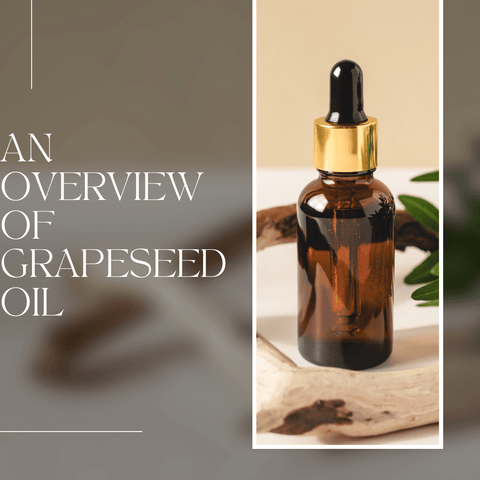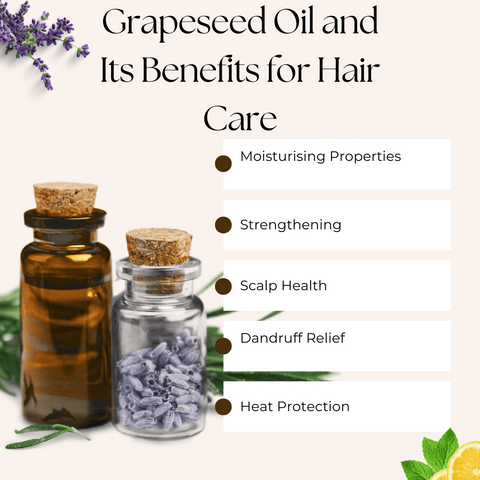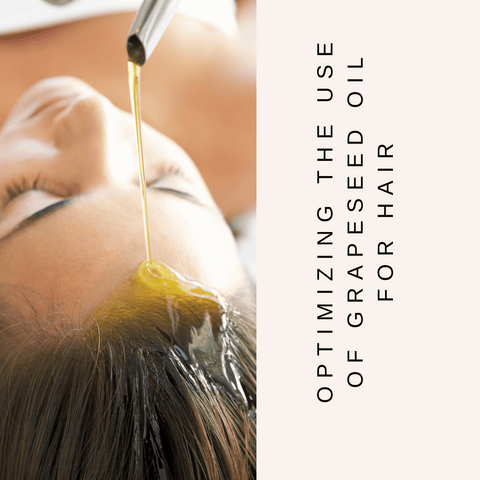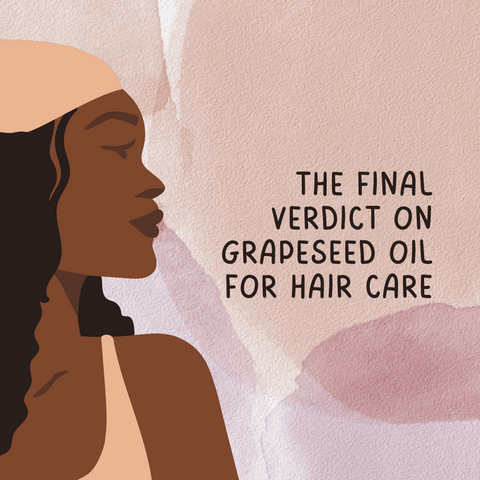Grapeseed oil has gained favor in recent years as a flexible ingredient in hair care due to its potential benefits for promoting healthy hair and scalp. This light, non-greasy oil derived from grape seeds is high in vital fatty acids, antioxidants, and vitamins, all of which contribute to its potential hair benefits. This blog is a deep examination of the wonders of grapeseed oil in hair care and how to use it effectively. Grapeseed oil has a number of hair care benefits, including moisturization, strengthening, and scalp health. You may unlock its potential and encourage healthier, more vibrant hair by carefully applying it to your hair care routine.
An Overview of Grapeseed Oil

Grapeseed oil is a versatile and well-known vegetable oil derived from grape seeds, which are typically utilised in winemaking or as a byproduct of the grape juice industry. It's popular because of its light texture, moderate flavor, and a slew of potential health and cosmetic benefits. Cold pressing is the procedure used to obtain grapeseed oil. The oil is extracted without the use of heat or chemicals by mechanically pressing the seeds. The finished oil is light in color and flavor. Grapeseed oil is rich in nutrients such as fatty acids, vitamin E, and antioxidants. Grapeseed oil is a versatile oil with a light texture, moderate flavour, and potential culinary and aesthetic benefits. Its fatty acid makeup, antioxidants, and potential health advantages make it a popular choice in a variety of applications.
Origins and Extraction of Grapeseed Oil
Grapeseed oil is a vegetable oil obtained from grape seeds, specifically byproducts of winemaking and grape juice production. Because of its high level of polyunsaturated fats and antioxidants, it has gained favor as a cooking oil and for its possible health advantages. Here's an outline of grapeseed oil's origins and extraction process:
-
Origins: Grapeseed oil has been utilised in numerous cultures for ages, mostly as a byproduct of winemaking. The seeds are left behind when the grapes are pressed to obtain their juice for winemaking. Historically, these seeds, which account for a large amount of the grape's weight, were discarded as garbage. It was eventually discovered, however, that these seeds contain oil with beneficial characteristics.
-
Extraction Process: The extraction of grapeseed oil includes the following steps: collecting and cleaning, drying, dehulling (optional), pressing, refining (optional), filtration, and bottling.
Nutrient Composition of Grapeseed Oil
Grapeseed oil is well-known for its high polyunsaturated fat and antioxidant content. Here is a general breakdown of grapeseed oil's nutrient profile:
Fats:
-
Grapeseed oil is mostly made up of fats, the majority of which are healthy unsaturated fats.
-
It is high in polyunsaturated fats, particularly omega-6 fatty acids like linoleic acid.
-
It also has monounsaturated fats, such as oleic acid, which is found in olive oil.
-
Vitamins:
-
Grapeseed oil contains trace amounts of vitamin E, a fat-soluble antioxidant that aids in the protection of cells against oxidative damage.
-
Phytosterols:
-
Phytosterols are plant compounds that have a similar structure to cholesterol. They can help lower cholesterol and improve heart health.
-
Grapeseed oil contains phytosterols, though the amount varies.
-
Antioxidants:
-
Grapeseed oil contains a high concentration of antioxidants, particularly proanthocyanidins, a type of flavonoid.
-
Proanthocyanidins have been linked to a number of health benefits, including anti-inflammatory and antioxidant properties.
-
Minerals:
-
Grapeseed oil contains trace amounts of phosphorus and potassium, among other minerals.
-
Other Compounds:
-
Grapeseed oil may also contain trace amounts of other bioactive compounds such as polyphenols.
It's worth noting that the particular nutrient makeup of grapeseed oil might vary depending on factors including grape varietal, processing processes, and extraction procedures. Grapeseed oil is frequently lauded for its high level of polyunsaturated fats and antioxidants, which can contribute to its possible health benefits, such as heart health and oxidative stress reduction. However, grapeseed oil, like any other oil, is high in calories, therefore, it should be consumed in moderation as part of a healthy diet. It's also important to evaluate the ratio of omega-6 to omega-3 fatty acids in your diet, as too much omega-6 fatty acid (found in large concentrations in grapeseed oil) can have negative effects on your overall health.
Grapeseed Oil and Its Benefits for Hair Care

Grapeseed oil is frequently used in hair care because of its possible benefits for fostering healthy hair and scalp. Here are some ways grapeseed oil can help with hair care:
-
Moisturising Properties: Grapeseed oil is a natural moisturiser that is lightweight and easily absorbed by the hair and scalp. It can assist in avoiding dryness and act as a protective barrier to keep moisture in.
-
Conditioning: The oil's emollient properties make it an excellent hair conditioner. It can make hair smoother and softer by improving its texture and manageability.
-
Strengthening: Vitamin E and linoleic acid, which are found in grapeseed oil, are thought to help maintain the strength and elasticity of hair. These vitamins and minerals might lessen breakage and split ends.
-
Scalp Health: Massaging grapeseed oil into the scalp can help improve blood circulation, promoting a healthier scalp environment. A healthy scalp is necessary for healthy hair growth.
-
Dandruff Relief: The anti-inflammatory and moisturising properties of grapeseed oil can help to soothe a dry, flaky scalp, potentially reducing the appearance of dandruff.
-
Heat Protection: Because grapeseed oil has a high smoke point, it can be used as a heat protectant for hair. Applying a small amount of oil to your hair before using heat styling tools can help minimise heat damage.
-
Detangling: Applying grapeseed oil to the hair can make it easier to detangle knots and knots, reducing hair breakage while combing or brushing.
-
Enhancement of Shine: Grapeseed oil can add natural shine to hair without leaving it greasy or heavy.
Before using any new oil or product on your hair or skin, conduct a patch test to rule out any adverse reactions. While grapeseed oil has a variety of hair care benefits, individual results may differ. If you have specific hair issues or conditions, seek customised counselling from a dermatologist or hair care professional.
Hydrating and Nourishing Effects
Grapeseed oil is well-known for its skin-hydrating and nourishing properties, making it a popular choice for skincare. Here's how grapeseed oil can help with these things:
Hydrating Effects:
-
Moisture Retention: Grapeseed oil contains a high concentration of fatty acids, including linoleic acid, which aids in the strengthening of the skin's barrier function. This barrier helps to keep the skin hydrated and moisturised by preventing water loss.
-
Quick Absorption: Grapeseed oil is light and easily absorbed by the skin. This rapid absorption aids in the delivery of moisture deep into the skin while leaving no greasy residue.
-
Non-Comedogenic: Grapeseed oil is non-comedogenic, which means that it is less likely to clog pores. This makes it appropriate for people with a variety of skin types, including those with oily or acne-prone skin who want hydration without causing breakouts.
Nourishing Effects:
-
Antioxidant Content: Grapeseed oil is high in antioxidants such as vitamin E and proanthocyanidins. These antioxidants help to neutralise free radicals, which can cause skin damage and premature aging.
-
Skin Barrier Support: The fatty acids in grapeseed oil can help to strengthen the skin's natural barrier, which is necessary for maintaining healthy, nourished skin.
-
Vitamin E: The vitamin E content of grapeseed oil contributes to its nourishing properties. Vitamin E is known to soothe and protect the skin, assisting in its health and appearance maintenance.
-
Soothing Properties: Grapeseed oil's anti-inflammatory properties can help calm and soothe irritated skin, making it useful for conditions like eczema or redness.
Before using grapeseed oil on your face or body, like with any skincare product, perform a patch test to ensure there are no adverse effects. Consider consulting a dermatologist before incorporating new products into your skincare routine if you have specific skin concerns or conditions.
The Role in Scalp Health and Dandruff Control
Grapeseed oil can play a beneficial role in promoting scalp health and controlling dandruff due to its moisturising, anti-inflammatory, and antioxidant properties. Here's how grapeseed oil can contribute to a healthy scalp and help manage dandruff:
-
Moisturising the Scalp: Grapeseed oil is lightweight and easily absorbed, making it an effective natural moisturiser for the scalp. Regularly applying grapeseed oil can help prevent dryness and flakiness, which are common factors contributing to dandruff.
-
Soothing Irritation: The anti-inflammatory properties of grapeseed oil can help soothe an irritated scalp. Dandruff is frequently associated with scalp inflammation, and grapeseed oil can provide relief and reduce redness.
-
Antioxidant Protection: Antioxidants in grapeseed oil, such as vitamin E and proanthocyanidins, can protect the scalp from oxidative stress and free radical damage. This shield can help to maintain general scalp health and avoid irritation.
-
Dandruff Control: While dandruff can have multiple causes, including fungal infections and dry skin, grapeseed oil's moisturising, and anti-inflammatory properties can help alleviate the symptoms. It can help reduce the appearance of flakes and the itching associated with dandruff.
How to Use Grapeseed Oil to Improve Scalp Health and Control Dandruff:
-
Scalp Massage: Warm a little amount of grapeseed oil with your hands and gently massage it into your scalp. This can enhance blood circulation, induce relaxation, and ensure that the oil is distributed evenly across the scalp.
-
Pre-Shampoo Treatment: Before shampooing, massage grapeseed oil into your scalp and hair. Allow it to sit on your scalp for 15-30 minutes to allow the oil to enter. As usual, wash your hair.
-
Leave-In Treatment: As a leave-in treatment, apply a few drops of grapeseed oil to your scalp after washing your hair. Observe the areas that itch or feel dry.
-
DIY Scalp Masks: You can make your own scalp masks by combining grapeseed oil with other healthy ingredients like tea tree oil, which is well-known for its ability to fight dandruff. Apply the concoction to your scalp, let it sit there for a short period of time, and then rinse it off.
-
Regular Use: Using grapeseed oil consistently is important for the health of your scalp. Regularly incorporate it into your hair care routine to reap the rewards over time.
Keep in mind that, while grapeseed oil can provide relief and improve the appearance of dandruff, it may not completely eliminate the underlying causes, particularly if the dandruff is caused by fungal infections. If you have persistent or severe dandruff, you should see a dermatologist for an accurate diagnosis and treatment recommendations.
Promoting Hair Growth and Preventing Hair Loss
Grapeseed oil may have some benefits for encouraging hair development and reducing hair loss, owing to its vitamin content and potential impacts on scalp health. While it is not a definite remedy, integrating grapeseed oil into your hair care routine may benefit overall hair health. Here's how it can help:
-
Scalp Health: A healthy scalp is necessary for hair growth. The moisturising and anti-inflammatory properties of grapeseed oil can help maintain a balanced and well-nourished scalp environment that is conducive to hair growth.
-
Strengthening and Nourishing: Vitamin E and linoleic acid, both of which are abundant in grapeseed oil, help to maintain the strength and elasticity of hair. A strong hair shaft that is less prone to breakage can support the growth of healthy hair.
-
Improved Blood Circulation: Massaging the scalp with grapeseed oil can improve blood circulation to hair follicles, delivering nutrients and oxygen more efficiently. This increased circulation has the potential to promote hair growth.
-
Antioxidant Protection: Grapeseed oil contains antioxidants that protect the scalp and hair follicles from oxidative stress. This protection can aid in avoiding harm that might stop hair growth.
-
Reduced Inflammation: Inflammation has been shown to have a negative impact on hair follicles and contribute to hair loss. The anti-inflammatory properties of grapeseed oil can help reduce inflammation on the scalp, potentially supporting a healthier hair growth environment.
-
Improved Hair Texture: Using grapeseed oil on a regular basis can help improve the texture of your hair, making it smoother, softer, and more manageable. Healthy hair is less likely to break and may appear fuller.
While grapeseed oil might help with general hair health, it's crucial to keep your expectations in check. Hair growth and loss can also be influenced by genetics, hormonal imbalances, and underlying medical conditions. If you're suffering considerable hair loss or have worries about the condition of your hair, it's best to seek customised advice from a healthcare practitioner or dermatologist.
Optimizing the Use of Grapeseed Oil for Hair

Follow these tips and guidelines to get the most out of grapeseed oil for your hair:
-
Choose High-Quality Oil: Look for grapeseed oil that is cold-pressed, organic, and unrefined. This preserves the oil's natural nutrients and properties.
-
Perform a Patch Test: Check for any allergies or sensitivities by applying a small amount of grapeseed oil to a patch of skin before applying it to your scalp and hair.
-
Scalp Cleaning: Prior to using grapeseed oil, make sure your scalp is thoroughly clean. A clean scalp allows the oil to be absorbed more effectively.
-
Warm the Oil: Before applying the grapeseed oil to your hair, gently warm it. Warm oil penetrates the hair and scalp more effectively, increasing its effectiveness.
-
Massage the Scalp: After applying the oil, gently massage your scalp in circular motions with your fingertips. This increases blood circulation and allows the oil to spread evenly.
-
Concentrate on the Ends: Apply the oil to the ends of your hair, which are more prone to dryness and damage.
-
Overuse: While grapeseed oil is beneficial, using too much can cause your hair to become greasy. Begin with a small amount and gradually increase as needed.
-
Leave It On: To deep condition your hair and scalp, leave the oil on for at least 30 minutes or overnight. In order to stop the oil from getting on your pillow, you can wrap your hair in a towel or wear a shower cap.
-
Use as a Heat Protectant: Before using heat styling tools, apply a few drops of grapeseed oil to your hair. This creates a shield between the heat and your hair, minimising damage.
-
Shampoo and Condition: After the recommended time, wash your hair with a mild shampoo to remove the oil. You might need to shampoo twice to ensure thorough cleansing. Follow up with a conditioner as usual.
-
Consistency is Key: The benefits of grapeseed oil for hair are best seen with regular application over time. The best results come from incorporating it into your regular hair care regimen.
-
Balanced Diet and Hydration: It is important to remember that hair health is not just about external treatments. A nutritious diet combined with adequate hydration promotes healthy hair growth.
-
Consult a Professional: Before making significant changes to your routine, consult a dermatologist or a hair care professional if you have specific hair concerns or conditions.
DIY Treatments with Grapeseed Oil
Here are a few simple DIY treatments that use grapeseed oil for various hair and skin care needs:
Grapeseed Oil Hair Mask: This mask can nourish and hydrate your hair, making it softer and easier to manage.-
Ingredients: 2 tablespoons grapeseed oil, 1 tablespoon honey, and 1 egg yolk.
-
Instructions:
-
In a mixing bowl, combine the grapeseed oil, honey, and egg yolk.
-
Apply the mixture to your scalp and hair, paying special attention to the ends.
-
Cover your hair with a towel or shower cap and leave the mask on for 30 minutes.
-
Wash your hair with a gentle shampoo and conditioner.
-
Ingredients: 2 tablespoons grapeseed oil and 2 tablespoons granulated sugar
-
Instructions:
-
Mix the grapeseed oil and granulated sugar in a bowl to create a paste.
-
Gently massage the scrub onto your damp skin in circular motions, focusing on areas with dry or rough skin.
-
Rinse thoroughly with warm water and pat your skin dry.
Grapeseed Oil and Aloe Vera Gel Serum: This serum can be used as a leave-in treatment to promote scalp health and hydrate your hair.
-
Ingredients: 3 tablespoons grapeseed oil, 1 tablespoon aloe vera gel and 5-10 drops of essential oil (optional, e.g., lavender or rosemary)
-
Instructions:
-
Mix the grapeseed oil and aloe vera gel in a bowl until well combined.
-
If using essential oil, add a few drops and mix again.
-
Apply a small amount of the serum to your scalp and massage gently.
-
Run your fingers through your hair to distribute the serum.
-
Leave it in and style your hair as usual.
-
Ingredients: 1 tablespoon grapeseed oil and 1 tablespoon brown sugar
-
Instructions:
-
Mix the grapeseed oil and brown sugar in a small bowl.
-
Gently massage the mixture onto your lips in circular motions for a minute.
-
Rinse off with warm water and follow with a lip balm.
Remember to perform a patch test before attempting any new DIY treatment to ensure there are no unwanted responses. Furthermore, these measurements are approximate, so feel free to change them based on the demands of your hair and skin. Enjoy the advantages of these natural therapies based on grapeseed oil!
Precautions When Using Grapeseed Oil
While grapeseed oil is generally considered safe for topical application and has numerous benefits for hair and skin care, there are a few precautions to be aware of:
-
Allergic Reactions: Some people are allergic to grapeseed oil or other components in it. Always perform a patch test by applying a small amount of oil to a small area of skin and waiting 24 hours to check for any adverse reactions.
-
Quality Matters: Use high-quality grapeseed oil, preferably cold-pressed and organic. Lower-quality oils may contain fewer nutrients and may have been diluted or mixed with other ingredients.
-
Clogged Pores: While grapeseed oil is non-comedogenic, which means it is less likely to clog pores, everyone's skin is different. If you notice any breakouts or skin congestion, reduce or stop using the oil.
-
Individual Sensitivity: Even if they are not allergic to grapeseed oil, some people may experience skin irritation or sensitivity when using it. If you experience any discomfort, stop using the product.
-
Eye Contact: Avoid getting grapeseed oil in your eyes, as it can cause temporary discomfort. If contact occurs, thoroughly flush your eyes with water.
-
Interactions with Other Products: When using grapeseed oil in combination with other skincare products, be aware of potential interactions. It is generally safe to combine with other carrier oils and some essential oils, but check compatibility first.
-
Medical Conditions: If you have allergies, skin diseases, or sensitivities, visit a dermatologist or healthcare expert before using new skincare products, including grapeseed oil.
-
Pregnancy and Breastfeeding: If you're pregnant or breastfeeding, it's always a good idea to consult your healthcare provider before using new products on your skin.
-
Internal Consumption: While grapeseed oil is safe for external use, avoid consuming it in large quantities. Grapeseed oil is often used for cooking, but excessive consumption might have health implications due to its omega-6 fatty acid content.
-
Children: Because children's skin is more sensitive, it is best to consult a pediatrician before using grapeseed oil on them.
Keep in mind that what works for one person may not work for another, so monitor how your skin and hair react to grapeseed oil. If you have any concerns or experience any side effects, you should always seek the advice of a healthcare professional or dermatologist.
Incorporating Grapeseed Oil in Modern Hair Care Products

Grapeseed oil's beneficial properties have led to its inclusion in many modern hair care products. Here are some ways in which grapeseed oil can be incorporated into various hair care products:
-
Shampoos and Conditioners: Grapeseed oil can be added to shampoos and conditioners to provide extra hydration, nourishment, and smoothness to the hair. Look for products that specifically mention grapeseed oil in their ingredient list.
-
Hair Masks and Treatments: Grapeseed oil can be a key ingredient in hair masks and deep conditioning treatments. These products offer intense hydration and repair for dry or damaged hair.
-
Leave-In Conditioners: Leave-in conditioners with grapeseed oil can help detangle hair, reduce frizz, and provide ongoing moisture throughout the day.
-
Hair Serums: Grapeseed oil can be used as a main ingredient in hair serums designed to provide shine, protect against heat damage, and tame flyaways.
-
Scalp Treatments: Scalp treatments containing grapeseed oil can help address dryness, itching, and flakiness. They may also promote a healthier scalp environment for improved hair growth.
-
Heat Protectants: Grapeseed oil's high smoke point makes it suitable as a heat protectant. Products formulated with grapeseed oil can shield hair from the damaging effects of heat styling tools.
-
Styling Products: Hair styling products such as mousses, gels, and creams may include grapeseed oil for their ability to provide hold and definition while maintaining hair's softness.
-
Anti-Frizz Products: Grapeseed oil's lightweight texture makes it an excellent ingredient in anti-frizz products that control flyaways and maintain smoothness.
-
Dry Shampoos: The moisturising properties of grapeseed oil can benefit dry shampoos, ensuring that hair does not become overly dry between washes.
-
Hair Perfumes and Oils: Grapeseed oil can serve as a carrier oil for hair perfumes and scented hair oils, providing fragrance while also nourishing the hair.
Check the ingredient list of hair care products using grapeseed oil to confirm that the oil is one of the primary components. Keep in mind that the concentration of grapeseed oil and other substances determines the product's efficacy. Furthermore, if you have specific hair issues or preferences, seek products that are geared to your needs, whether it's hydration, frizz control, hair growth, or scalp health. Patch-test new hair care products, just like any other product, to ensure they are well-tolerated by your skin and hair.
Grapeseed Oil-Based Hair Care Products in the Market
The formulas, objectives, and advantages of these products differ. Keep in mind that exact product availability may have changed since then. Shampoos and conditioners, hair masks and treatments, serums and oils, leave-in conditioners, scalp treatments, heat protectants, styling products, anti-frizz products, dry shampoos, and hair scents and mists are all examples of grapeseed oil-based hair care products. When looking into these products, make sure to read the ingredient lists, product descriptions, and customer reviews to learn how grapeseed oil is used and what benefits it may provide. Keep in mind that everyone's preferences, hair types, and demands are different, so what works well for one person may not work well for another. Before using a new product extensively, try a patch test if you can to prevent negative reactions.
Assessing the Effectiveness of Grapeseed Oil Hair Care Products
Assessing the efficacy of grapeseed oil hair care products requires looking at things like how they affect hair health, texture, and appearance, as well as how well they meet certain goals or concerns. Observe hair texture and appearance, check for hydration, frizz control, detangling and manageability, heat protection, scalp health, hair growth and thickness, reduced irritation, long-term results, personal goals, and needs, feedback from others, and minimal adverse reactions to evaluate the efficacy of these products. Keep in mind that hair care products perform differently for each individual due to factors such as hair type, individual demands, and overall hair care routine. Experiment with several products and give them time to produce results. If you find that a specific grapeseed oil-based product consistently meets your hair care needs, it is most likely effective for you.
The Final Verdict on Grapeseed Oil for Hair Care

The final word on grapeseed oil for hair care is that it can be a vital and beneficial item to add to your routine, but only if you evaluate your unique hair needs and goals. Grapeseed oil may be beneficial for a variety of reasons, including moisturising, nourishing, increasing scalp health, and stimulating hair development. However, its effectiveness varies from person to person, and it is critical to temper expectations and recognise that improvements may take time to become visible.
Consider the following key points:
Pros of Using Grapeseed Oil for Hair Care:
-
Lightweight Moisturization: Grapeseed oil is easily absorbed and provides lightweight moisture without leaving hair greasy.
-
Scalp Health: It can help keep the scalp healthy, potentially reducing dandruff and irritation.
-
Antioxidant Protection: The antioxidants in grapeseed oil can shield hair from oxidative stress and environmental harm.
-
Versatility: Grapeseed oil can be used in a variety of ways, including on its own, as a component of homemade remedies, and as a hair care product.
-
Frizz control: It can aid in controlling frizz, giving hair a smoother, more manageable appearance.
-
Detangling: Grapeseed oil can facilitate detangling and lessen hair breakage.
Cons and Considerations:
-
Individual Variation: Grapeseed oil does not work the same way on everyone's hair. It is possible that some people get better outcomes than others.
-
Delayed Results: It might take some time before noticeable hair improvements, like increased thickness or growth, are seen.
-
Allergic Reactions: Before using extensively, a patch test is crucial because allergic reactions or sensitivities are possible.
-
Supplemental Therapy: Although grapeseed oil can support healthy hair, it might not be sufficient to treat underlying medical conditions or more serious cases of hair loss.
-
Balanced Approach: Although helpful, grapeseed oil should only be used as a small part of a comprehensive hair care regimen that also includes good nutrition, hydration, and general hair care techniques.
Incorporating grapeseed oil into your hair care routine can be beneficial, especially if you are looking for natural, lightweight moisturization and scalp health support. Start with patch tests, take into account your hair type and specific concerns, and be patient as you observe how your hair responds. If you have serious hair problems, it is best to consult a dermatologist or hair care professional for personalised advice and recommendations.

















2 comments
Prachi burande
Kya dailya hair par grapessed oil lagane ke bad hair wash karna padega
Kya dailya hair par grapessed oil lagane ke bad hair wash karna padega
Dr Anchal Kumra
Pls recommend good grapeseed oil and black cumin seed oil
Pls recommend good grapeseed oil and black cumin seed oil